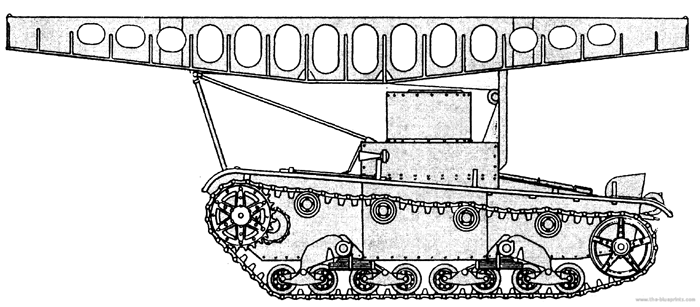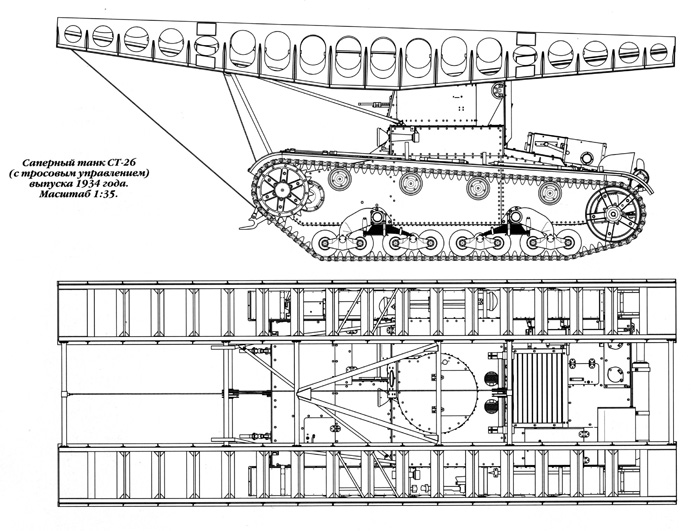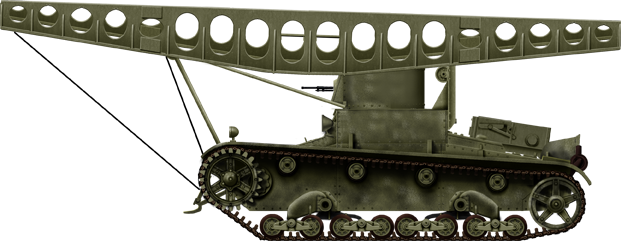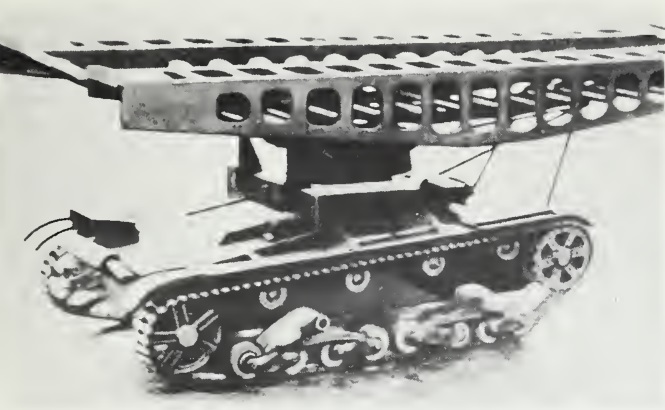The First Soviet Bridgelayer
About the T-26
The T-26 light tank was the imported British Vickers E (6 tons), purchased in 1930, four purchased by the Soviet delegation without armament, two with two turrets and two with single turrets. It was mass-produced back home in three main models, the last in 1937. This made the Red Army the world's largest tank force, but still constituted the bulk of Soviet armoured divisions in the summer of 1941, the production being terminated after 10k vehicles, and focused on the more promising T-34 and KV-1.The T-26 was available in such quantities it was soon giving birth to circa fity variants and sub-variants. These specialized vehicles ranged from flamethrower to prime movers, armoured personal carriers, self propelled guns and engineering vehicles. Most were experimental, testing new concepts for the Red Army in all roles and duties, some having a more limited production. Among those actually seeing a sizeable production and combat were the T-26T prime mover and ST-26 engineering tank, the first Soviet operational bridgelayer.
Development

The cable laying variant
The ST-26 was developed as a bridgelayer, and named "engineer tank" abberviated as "ST", standing for "saperniy tank". This early bridge-laying tank was based on the twin-turreted T-26 model 1931. It was not seen as obsolete by the time this development started, but this later came out handy to justify conversions. As per the armoured engineering documents of the Red Army, it came from an idea of the Academy of Military Engineering under Gutman in the start of 1932.The ST-26 retaned a single shortened turret relocated in the middle of the roof, and housing a DT tank machine gun with 1,008 rounds, 211° arc of fire as close defence. It carried a metal tracked bridge measuring 7.35 m (24.1 ft) long overall, 1,100 kg (2,400 lb). There were for support a front frame with two forks, two guiding rollers and lower forks with a hoisting mechanism and roller. There was also a rear frame with mounts plus two rollers, cable winch driven by the tank engine on its reversing gear. All the operatons could be done from inside the tank.
As tested, this ST-26 prototype was to be capable of providing crossing for of trenches or water obstacles up to 6 or 6.5 meters (20–21 ft). It was usable to also climb a two meter tall (6.6 ft) obstacle or step. It was also to support the T-27, T-26 and BT tanks (maximum load 14 tonnes or 15 short tons). The bridge was deployed, retains by the cable winch in 25–40 seconds, raised and installed in 2-3 min. However someone as to exit and coversee the operation still. This first cable laying ST-26 was tested in the summer of 1932.
The sliding and tipping bridgelaying variants
Additional variants, notably with a sliding bridge laying system and a tipping system ST-26 prototypes were tested from 1932 onwards. The first had a massive guide frame plus a special boom to lay the bridge could in 3 min 20 sec. raised in 6-7 min. and the second equipped with a special swinging-boom using a rack-and-pinion drive. These three prototypes took part in military maneuvers at the Leningrad Military District's proving grounds by the summer of 1933.In the final report, it was recommended to produced the cable laying variant of the ST-26 as it proved more reliable, less complicated to maintain. The Defence Committee thus soon order 100 ST-26 by the end of 1933. Only 44 were assembled at the Factory No.174 by 1934, 20 in 1935, delayed by the manufacture of the metal bridge at Gipstalmost Factory and other workshops, using semi-manual techniques. The final production ST-26 was weighting with the bridge up to 10 tonnes (11.0 short tons), kept a crew of two with the commander and driver and was slower at 28 km/h (17 mph), with a range of just 120 km (75 mi).
The lever hydraulic variant
By the fall of 136, the Armoured Engineering Section and Research Institute of Engineer Equipment and Gipstalmost Factory started an improved version of the ST-26 using a more modern lever hydraulic system, inspired by the UST-26. It also had a small turret of new design. The whole operation was faster, in 45 sec. raising in 1.5 min and both the crew remained inside all along. The Podolsk Machine Factory "Ordzhonikidze" produced a prototype by July 1937, successfully tested at the NIIIT Proving Ground, performing 85 bridge layings, 70 light tanks crossings and later at the official Kubinka Tank Proving Ground, as well as in military exercises (Leningrad Military District) in 1938. Decision was made in 1939 to produce a few ST-26s with the lever hydraulic system, but only one was made,two at the Stalingrad Tractor Factory (allegedly), so four with the prototypes.The multispan variant
A multispan bridgelayer protytype was developed in 1934 to allow up to three ST-26 bridges connected together using special automatic grips at both section ends. They were also sat down using 250 kg metal columns, 2.5 m (8.2 ft) tall, to cross 20–50 m (66–164 ft) wide water obstacles, 3 m (9.8 ft) deep. The launching of each bridge section took 20-30 min. But it was found unstable and fragile, and development stopped after testing.The Wooden tracked Bridge
Engineer Alexandrov (Research and Technology Division, Red Army's Engineer Directorate) developed also a wooden tracked bridge 6.5 m (21 ft) long in 1934. This new type of bridge used on-strategic materials for mass production and could be mounted on a standard T-26 light tank as well as the ST-26 engineer tank, laid in 30-60 sec. Again, not need of a crew exit. Trials in the summer of 1934 were successful. 20 wooden tracked bridges were issued.UST-26
The "usovershenstvovanniy saperniy tank" ("improved engineer tank") model 1936 was an improved ST-26. Since the latter was abundantly testes, it demonstrated its low reliability, wire cables breaking, twisting, supports bending... The designers camle from the same institute (NIIIT RKKA) and again worked with Gipstalmost Factory under supervision of the engineers Vayson, Nemets and Markov. The UST-26 used two levers and a hydraulic cylinder. Factory No. 174 and the Podolsk Machine Factory made two UST-26 in 1936, trialled from March 1936 and showing a definitive improvement, but it had its own disadvantages and production was not greenlighted.Design

The ST-26 weighted from 9.5 to ten tons and was very much still close to the original vehicle. The obvious features added were the frame apparatus installed around the turret to support the doubled bridge. The double span bridge was composed of two support tracks, connected by a ladder type structure. It was articulated and rested on six points: he main "H" support was located behind the turret. There was another contact point above the turret roof, a V type strut connecting to the forward intermediate beam, and two connecting rods, anchored at the base of the tank casemate, the other main support pair articulated at the end of the nose, front glacis. The main winch connected to the transmission activated a roller on which two cables weere anchored, one on the intermediuate forward roller, the other on the bridge's end roller. The bridge would be then raised forward, lowered until making ground contact, and then pushed forward until completely flipped over over the obstacle.
Mobility
The T-26T and the ST-26 kept the same standard engine as the T-26, initially TMM-2 (low power) and later the copied Vickers Armstrong Siddeley 90 hp model, flat row 4-cylinder, air-cooled petrol engine enabling a range of 122-183 km, top speed 30 kph down to 18 cross country. Still the ST-26 was underpowered.Protection and defence
The ST-26 had a riveted hull, with a hull Front 15mm thick, Side 10mm, Rear 10mm, Top 8mm, Hull Bottom 8mm. It was proof against small arms fire, antitank rifle fire forward. The tailored turret was only protected against 8 mm rifle fire and shrapnels. Armament was limited to the single DT 7.62 mm machine gun with 1008 rounds.Production and Combat Use
71 ST-26 were produced in 1932–1939, including 65 ST-26 with cable-laid system, a single ST-26 with sliding bridge, single ST-26 with tipping bridge, two UST-26 and two ST-26 with the same levered bridge-laying system.Ten ST-26s were used on the Karelian Isthmus, Winter War, nine with cable system, one with a lever system as per engineer groups created for obstacle clearing. They were organic to each tank brigade. Three ST-26s from the 35th Light Tank Brigade gaped a trench and antitank ditch enabling the tank battalion to cross and perform an assault on the fortified High Point 65.5 in the Hottinen area of the Mannerheim Line, on February 18, 1940. The single ST-26 (lever system) was also used well in the Winter War, more so than cable system ST-26 that proved unreliable. No losses of ST-26s were reported.
At the time of Operation Barbarossa by June 1941, Tank units deployed fifty-seven ST-26 engineer tanks, nine in the Far Easter, twenty-six in the Moscow Military District, two in the Leningrad Military District, two in the Kiev Special Military District, eight in the Western Special Military District, a single one in the Volga Military District, and nine in reserve depots. Only 12 of this total were in good order, the others needed maintenance and repairs.
They were quickly destroyed apart those far from the frontline, which survived until 1942-43 until the lack of parts and maintenance had them inoperative. None survived the war.
ST-26 specifications | |
| Dimensions (L-w-h) | 7.35 x 3.80 x 2.20m |
| Total weight, battle ready | 9.5–10 tonnes (11 short tons) |
| Crew | Driver, Commander |
| Propulsion | 90 bhp flat row 4-cylinder air-cooled petrol engine |
| Speed | 26-28 km/h (16 mph) |
| Range | 120 km (75 mi) |
| Armament | 1x 7.62 mm DT, 1000 rds |
| Armor | 6–15 mm (0.24–0.59 in) |
| Total production | c71 |
Src read more
armchairgeneral.comarmedconflicts.com
scalemates.com

Rendition of the ST-26



WW2 Tanks




























WW2 tanks posters

All Tiger tanks liveries.

Panther liveries and variants

WW2 Armour - All tanks











Tanks aces and single tanks series

Find more there

Museums, Movies, Books & Games
The Tanks and Armor in pop culture
Tanks and armored vehicles in general are only really grasped when seen first person: The mass, the scale, it's all there. Explore also the way tanks were covered in the movie industry, in books and in video games.Movies:
Best tanks movie on warhistoryonline.com
On imdb.com
On bestsimilar.com/
miltours.com
liveabout.com/
watchmojo.com
Video Games:
pcgamesn.com
historyhit.com
levvvel.com
vg247.com/best-tank-games
mmobomb.com/
alienwarearena.com

